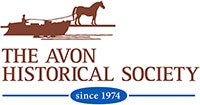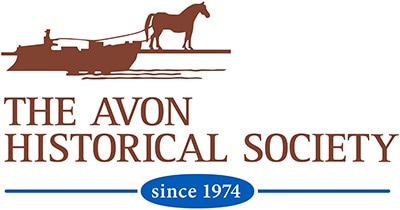Historic Homes
Dated 1745, the colonial "saltbox" home on the right, located on Waterville Road (Route 10), retains many period features, blending the character of early New England architecture with discrete modern additions.
The Society receives many inquiries from people interested in the unique history of their own home or other old buildings in our lovely town. In 1997, The State Historic Commission surveyed a "representative selection" of historic properties. Since that time, some of the identified buildings have been renovated while others no longer exist. All properties change over time as a town grows and as people move on. We are very fortunate that a local Eagle Scout, Micah Rahardjo, updated this report in 2017.
In keeping with the way people frequently access records online, scans of these reports and plans have been digitized. Photographs were taken for listed buildings still standing, but several have been demolished even in the span of 20 years. You may view these records by visiting the Avon Library’s website or accessing the Connecticut Digital Archive and searching for Avon Historic Homes, then entering the street name for the specific property. Keep in mind the information compiled in that 1997 report came from the Avon Town Accessor record and a visual driveby of the writers of the report. You may also click here to view a representative list of historic homes that is updated periodically.
If you would like more information or have some additional research to contribute, please contact us or make an appointment to visit the Marion M. Hunter History Room at the Avon Public Library where files on most historic homes are maintained.
History is a two-way process of discovery, so the mutual sharing of our community records is vital for future generations.
A Sampling of Avon's Historic Homes
Wood Ford Farm House (1785)

The house at 45 Nod Road in Avon was built c. 1785-1789. It has been much altered over the years, acquiring several additions. In the 1830s the house was owned by Amasa Woodford, who was part of the movement that led to Avon becoming an independent town in 1830. Part of the Woodford family farm, which has been in continuous operation since 1666, is now the Pickin’ Patch on Nod Road. In 1905 the house was acquired by Joseph Wright Alsop IV (1876-1953), a gentleman farmer, insurance executive and member of a well-known political family. Alsop was a member of Connecticut’s House of Representatives, 1907-1908 and state senate, 1909-1912. He also served as a First Selectman in Avon from 1922 to 1950. He was married to Corinne Robinson Alsop (1886-1971), a niece of President Theodore Roosevelt and a leading suffragist. Corinne Robinson Alsop who served in the state House of Representatives in 1924–1927 and again in 1931–1933. While owned by the Alsops, the house was part of their large stock-breading and dairy business called Wood Ford Farm. They added the house’s Colonial Revival front portico in the 1930s. Her husband died in 1953 and in 1956 Corinne remarried Francis W. Cole, former chairman of the Travelers Insurance Company. The house is located adjacent to Blue Fox Run Golf Course.
The Rufus Hawley House (1799)

Rev. Rufus Hawley built the house he owned in Avon in 1798-1799. Located at 281 Old Farms Road, it was notable for having two side-by-side kitchens in the rear. Known as Avonside, it remained in the family for many years after the minister’s death. It passed to his son, Rufus Forward Hawley, who sold it to his nephew, Edward Eugene Hawley in 1837. After his death in 1868, it passed to Edward’s daughters, Florence Genevieve Hawley, who used it as a summer home, and then to Bertha H. Hawley. It was then inherited by their nephew, Reginald Birney of West Hartford, who died in 1936. Damaged by fire in 1950, the house was sold by Birney’s widow in 1951 to Robert and Gladys August, who also became the guardians of the Hawley family papers, including the journals. They owned the house until 1998. In 2002, the Hawley family archives were donated to the Avon Free Public Library. Nora Howard, Avon Town Historian, transcibed those journals and published them in to a book, "Catch'd on Fire" available through the Society gift shop.
Chester R. Woodford House (1850)

The farmhouse at 215 Nod Road in Avon was built c. 1850 by Chester Randolph Woodford (1814-1921), a dairy and tobacco farmer who lived to the age of 107. As a young man he was a clock salesman. Woodford was the first farmer in Avon to grow tobacco. He started with broadleaf for cigar wrappers and, with his son Prescott, began to grow shade tobacco in 1905. Tobacco was grown by the family into the 1980s. The farm, now called the Pickin’ Patch, then switched to growing vegetables and berries, but the property still has a number of historic tobacco sheds.
Ensign-Bickford Houses (1913)

In 1892 the Ensign-Bickford Company of Simsbury acquired a half interest in the Climax Fuse Company of Avon. By 1907 the companies merged. Following its practice in Simsbury, Ensign-Bickford erected housing for its workers in Avon, including a number of houses built c. 1913 around a small green called Farmington Court. Unusually for the time these were mostly single-family homes instead of multi-family tenements. This was part of a new movement in which industrial companies began erecting suburban-type neighborhoods for their workers. Farmington Court was renamed Columbus Circle in 1930, but which time the residents were primarily Italian-Americans. The Prince Thomas of Savoy Society, an Italian-American social club, built its headquarters nearby in 1932. Other company houses are located along Enford Street and Mountain View Avenue.


